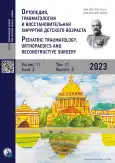«Человеческий хвост». Сообщение о случаях ретропозиции копчика у детей
- Авторы: Трофимова С.И.1, Буклаев Д.С.1, Мурашко Т.В.1
-
Учреждения:
- Национальный медицинский исследовательский центр детской травматологии и ортопедии имени Г.И. Турнера
- Выпуск: Том 11, № 2 (2023)
- Страницы: 209-217
- Раздел: Клинические случаи
- Статья получена: 09.05.2023
- Статья одобрена: 25.05.2023
- Статья опубликована: 30.06.2023
- URL: https://journals.eco-vector.com/turner/article/view/397591
- DOI: https://doi.org/10.17816/PTORS397591
- ID: 397591
Цитировать
Аннотация
Обоснование. «Человеческий хвост» — редкий врожденный порок развития, представляющий собой выпячивание на дорсальной поверхности поясничной, крестцово-копчиковой или параанальной области.
Клинические наблюдения. Цель этой статьи заключается в демонстрации трех редких клинических случаев выступающего в виде хвостовидного образования удлиненного копчика у детей. Пациенты обратились к нам в связи с появлением боли в положении сидя и ежедневный дискомфорт, так как это образование практически не имело других тканей, кроме копчиковых позвонков. У пациентов не было неврологического дефицита и нарушений функций тазовых органов. По данным лучевых методов диагностики и магнитно-резонансного исследования во всех случаях определена ретропозиция копчика с отсутствием его типичной передней ангуляции, в одном случае копчик представлен 4 удлиненными позвонками без типичного уменьшения размеров позвонков в каудальном направлении, в 2 случаях отмечена угловая деформация копчика на уровне CoIII с величиной межкопчикового угла 138 и 140°.
Обсуждение. В описанных нами случаях хвостовидные образования могут быть отнесены к «псевдохвостам» по классификации A.H. Dao и M.G. Netsky (1984) и к «человеческим хвостам» типа Iа по классификации S. Tojima и S. Yamada (2020).
Заключение. Важнейшая особенность хвостовидных образований — связь со скрытыми формами спинальной дизрафии, в связи с чем необходимо проведение в каждом случае всестороннего предоперационного обследования (неврологический осмотр, лучевые методы диагностики и магнитно-резонансное исследование). Неосторожная хирургическая абляция может привести к серьезным последствиям, которые значительно ухудшат качество жизни пациентов.
Полный текст
Об авторах
Светлана Ивановна Трофимова
Национальный медицинский исследовательский центр детской травматологии и ортопедии имени Г.И. Турнера
Email: trofimova_sv2012@mail.ru
ORCID iD: 0000-0003-2690-7842
SPIN-код: 5833-6770
Scopus Author ID: 57193275907
канд. мед. наук
Россия, Санкт-ПетербургДммитрий Степанович Буклаев
Национальный медицинский исследовательский центр детской травматологии и ортопедии имени Г.И. Турнера
Email: dima@buklaev.com
ORCID iD: 0000-0003-1868-3703
SPIN-код: 4640-6856
канд. мед. наук
Россия, Санкт-ПетербургТатьяна Валерьевна Мурашко
Национальный медицинский исследовательский центр детской травматологии и ортопедии имени Г.И. Турнера
Автор, ответственный за переписку.
Email: popova332@mail.ru
ORCID iD: 0000-0002-0596-3741
SPIN-код: 9295-6453
врач-рентгенолог
Россия, Санкт-ПетербургСписок литературы
- Dao A.H., Netsky M.G. Human tails and pseudotails // Hum. Pathol. 1984. Vol. 15. No. 5. P. 449–453. doi: 10.1016/s0046-8177(84)80079-9
- Giri P.J., Chavan V.S. Human tail: a benign condition hidden out of social stigma and shame in young adult – a case report and review // Asian J. Neurosurgery. 2019. Vol. 14. No. 1. P. 1–4. doi: 10.4103/ajns.AJNS_209_17
- Hamoud K., Abbas, J. A tale of pseudo tail // Spine. 2011. Vol. 36. No. 19. P. E1281–E1284. doi: 10.1097/BRS.0b013e31820a3dd9
- Lin P.J., Chang Y.T., Tseng H.I., et al. Human tail and myelomeningocele // Pediatr. Neurosurg. 2007. Vol. 43. No. 4. P. 334–337. doi: 10.1159/000103318
- Cai C., Shi O., Shen C. Surgical treatment of a patient with human tail and multiple abnormalities of the spinal cord and column // Adv. Orthop. 2011. Vol. 2011. doi: 10.4061/2011/153797
- Tojima, S., Yamada, S. Classification of the “human tail”: Correlation between position, associated anomalies, and causes // Clinical Anatomy. 2020. Vol. 33. No. 6. P. 929–942. doi: 10.1002/ca.23609
- Katsuno S., Horisawa, M. A case of perianal human tail // J. Jpn. Soc. Pediatr. Surg. 2008. Vol. 44. P. 808–813.
- Saka R., Hasegawa T., Sonobe, H. A case of perianal human tail // Journal of Japanese College of Surgeons. 2010. Vol. 35. P. 85–88.
- Falzoni P., Boldorini R., Zilioli M., et al. The human tail. Report of a case of coccygeal retroposition in childhood // Minerva Pediatr. 1995. Vol. 47. No 11. P. 489–491.
- Мохаммад Б., Давлицаров М.А., Цыбин А.А., и др. Истинный хвост с дистальным удвоением у новорожденного // Детская хирургия. 2015. T. 19. № 4. С. 53–54.
- Wilkinson C.C., Boylan A.J. Proposed caudal appendage classification system; spinal cord tethering associated with sacrococcygeal eversion // Childs. Nerv. Syst. 2017. Vol. 33. No. 1. P. 69–89. doi: 10.1007/s00381-016-3208-x
- Ersahin Y., Gezen F., Bedük A.B. Neuroectodermal appendage: a case report and review // Turkish Neurosurgery. 1993. Vol. 3. No. 1. P. 25–27.
- Iqbal Z., Cejudo-Martin P., de Brouwer A., et al. Disruption of the Podosome adaptor protein TKS4 (SH3PXD2B) causes the skeletal dysplasia, eye, and cardiac abnormalities of Frank-Ter Haar syndrome // Am. J. Hum. Genet. 2010. Vol. 86. No. 2. P. 254–261. doi: 10.1016/j.ajhg.2010.01.009
- Sirmaci A., Walsh T., Akay H., et al. MASP1 mutations in patients with facial, umbilical, coccygeal, and auditory findings of Carnevale, Malpuech, OSA, and Michels syndromes // Am. J. Hum. Genet. 2010. Vol. 87. No. 5. P. 679–686. doi: 10.1016/j.ajhg.2010. 09.018
Дополнительные файлы




















